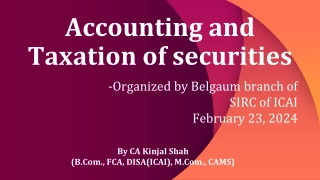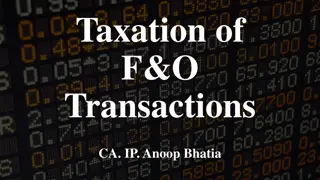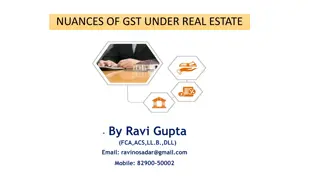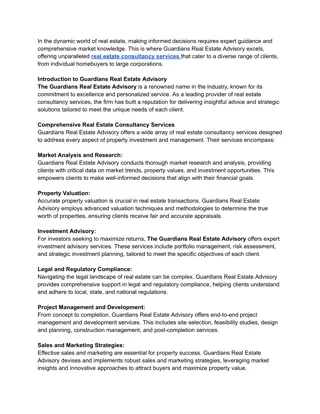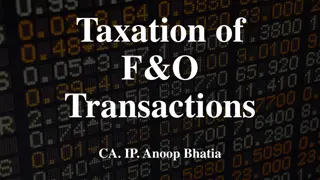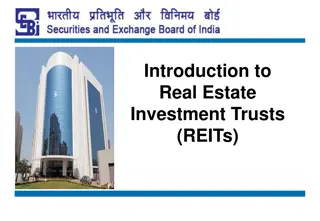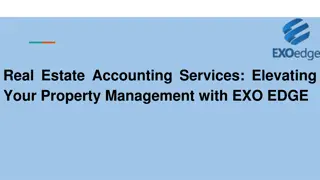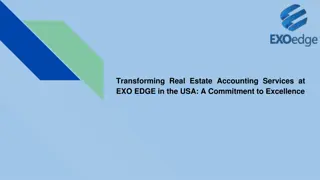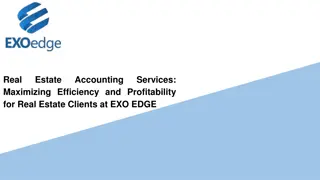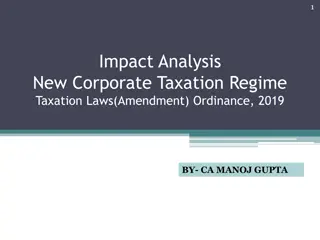Accounting and Taxation of Real Estate Transactions Presentation
Explore the intricacies of accounting and taxation related to real estate transactions in this presentation organized by the Saharanpur Branch of ICAI. Delve into topics such as construction contracts, real estate developers, revenue recognition, tax implications, and distinctions between developer and builder models in construction contracts.
Download Presentation

Please find below an Image/Link to download the presentation.
The content on the website is provided AS IS for your information and personal use only. It may not be sold, licensed, or shared on other websites without obtaining consent from the author. Download presentation by click this link. If you encounter any issues during the download, it is possible that the publisher has removed the file from their server.
E N D
Presentation Transcript
PRESENTATION ON PRESENTATION ON ACCOUNTING AND TAXATION OF REAL ESTATE TRANSACTIONS ORGANISED BY BRANCH OF CIRC OF ICAI ON SEPT 05, 2014 AT SAHARANPURBRANCH OF CIRC OF ICAI Presented by: CA Verendra Kalra
PRESENTATION ON ACCOUNTING AND TAXATION OF REAL ESTATE TRANSACTIONS The following are the forms: Construction Contracts Real Estate Developers ACCOUNTING AND TAXATION OF REAL ESTATE TRANSACTIONS 2
PRESENTATION ON ACCOUNTING AND TAXATION OF REAL ESTATE TRANSACTIONS Most of the accounting issues relating to recognition of revenue, assets and liabilities arise on account of the matching principle. The problems arising on application of the principles of mercantile system of accounting are perhaps not more pronounced in any industry than in the construction industry. Our discussion will be focused on the following aspects: 1) Accounting aspect: Nature of accounting issuesfaced while accounting for construction contracts: ACCOUNTING AND TAXATION OF REAL ESTATE TRANSACTIONS 3
PRESENTATION ON ACCOUNTING AND TAXATION OF REAL ESTATE TRANSACTIONS contractual activity covers more than one accounting period Accounting issues Accounting of forseeable losses Recognition of Revenue Recognition of Cost ACCOUNTING AND TAXATION OF REAL ESTATE TRANSACTIONS 4
PRESENTATION ON ACCOUNTING AND TAXATION OF REAL ESTATE TRANSACTIONS 2. Issues on account of stance taken by the tax authorities Income Tax Service Tax State VAT ACCOUNTING AND TAXATION OF REAL ESTATE TRANSACTIONS 5
PRESENTATION ON ACCOUNTING AND TAXATION OF REAL ESTATE TRANSACTIONS DISTINCTION BETWEEN DEVELOPER MODEL AND BUILDER MODEL OF CONSTRUCTION CONTRACT S.No. Point of Distinction Builder Model Developer Model 1 Modus Operandi Agreement executed with the intending purchaser. Conveyance is executed by builder after completion of building and thereafter possession given. The conveyance is in respect of land as well as construction. to Sale is Developer contract with prospective buyers (allotees). owner of land directly transfers the entire land to society/owners apartment, as the case may be. As a result of foregoing transfer, they become owners undivided share of land. enters into The is of of ACCOUNTING AND TAXATION OF REAL ESTATE TRANSACTIONS 6
PRESENTATION ON ACCOUNTING AND TAXATION OF REAL ESTATE TRANSACTIONS S.No. Point of Distinction Builder Model Developer Model 2 Quantum of Stamp Duty Stamp duty is payable only after completion construction in respect of constructed flat/shop which includes the value of land also. It is well known fact that value of constructed flat is more than value of mere land. more amount of stamp duty is payable. Stamp duty is payable only when land is transferred to society/owner. developer construction on behalf of intended Consequently, comparatively less amount of stamp duty is payable. of The does purchaser. Resultantly, ACCOUNTING AND TAXATION OF REAL ESTATE TRANSACTIONS 7
PRESENTATION ON ACCOUNTING AND TAXATION OF REAL ESTATE TRANSACTIONS ACCOUNTING ASPECT CONSTRUCTION CONTRACTS Accounting for construction contracts is done on the basis of AS-7 which prescribes the standard to be followed. AS-7 was first issued in 1983 and was revised in the year 2002. ACCOUNTING AND TAXATION OF REAL ESTATE TRANSACTIONS 8
PRESENTATION ON ACCOUNTING AND TAXATION OF REAL ESTATE TRANSACTIONS Salient Features of AS 7 (Revised) The standard applies only to accounting for construction contracts. It doesn t apply to accounting for real estate development undertaken as a venture by an enterprise, as was possible with the earlier standard. The standard prescribes only the PCM for revenue recognition. ACCOUNTING AND TAXATION OF REAL ESTATE TRANSACTIONS 9
PRESENTATION ON ACCOUNTING AND TAXATION OF REAL ESTATE TRANSACTIONS Types of construction contracts Fixed Price- Contract price is fixed, with or without escalation clause. Cost plus Revenue- Cost +Agreed Percentage To book revenue, it is necessary to estimate the outcome reliably. In both these cases, the criteria to be satisfied are as under: ACCOUNTING AND TAXATION OF REAL ESTATE TRANSACTIONS 10
PRESENTATION ON ACCOUNTING AND TAXATION OF REAL ESTATE TRANSACTIONS Fixed Price Cost plus _ Total contract revenue can be measured reliably; It is probable that the economic benefits associated with the contract will flow to the enterprise; Both the contract costs to complete the contract and the stage of contract completion at the reporting date can be measured reliably; and It is probable that the economic benefits associated with the contract will flow to the enterprise; _ ACCOUNTING AND TAXATION OF REAL ESTATE TRANSACTIONS 11
PRESENTATION ON ACCOUNTING AND TAXATION OF REAL ESTATE TRANSACTIONS The contract costs attributable to the contract can be clearly identified and measured reliably so that actual contract costs incurred can be compared with prior estimates. The contract costs attributable to the contract, whether or not specifically reimbursable, can be clearly identified and measured reliably. ACCOUNTING AND TAXATION OF REAL ESTATE TRANSACTIONS 12
PRESENTATION ON ACCOUNTING AND TAXATION OF REAL ESTATE TRANSACTIONS Contract Revenue & Expenses Revenue shall include the following: Initial amount of revenueagreed Escalations, Claims, etc. Variation in contract work, claims, incentive payments, provided it is probable that the principle will accept the claim. ACCOUNTING AND TAXATION OF REAL ESTATE TRANSACTIONS 13
PRESENTATION ON ACCOUNTING AND TAXATION OF REAL ESTATE TRANSACTIONS Expenses consist of the following: Costs that relate directly to the specific contracts Costs that can be allocated to the contract, Costsspecifically chargeable to the customer under the terms of the contract. ACCOUNTING AND TAXATION OF REAL ESTATE TRANSACTIONS 14
PRESENTATION ON ACCOUNTING AND TAXATION OF REAL ESTATE TRANSACTIONS Contract costs Following are the costs which should be included and excluded while determining the contract cost: ACCOUNTING AND TAXATION OF REAL ESTATE TRANSACTIONS 15
PRESENTATION ON ACCOUNTING AND TAXATION OF REAL ESTATE TRANSACTIONS Inclusions Site Labour Material Depreciation on Plant used in contract Cost of hiring, designing Claim from 3rd Parties Pre Contract Cost, if it is probable that contract cost will be obtained Net off Incidental Income if not included in revenue (Scrap of material) Exclusions General Administrative & Overhead Cost Selling Cost Research & Development Depreciation of Idle Plant Cost incurred in securing the contract Cost such as material set aside but not used and applied Payments made to sub- contractor in advance of work performed under the sub contract ACCOUNTING AND TAXATION OF REAL ESTATE TRANSACTIONS 16
PRESENTATION ON ACCOUNTING AND TAXATION OF REAL ESTATE TRANSACTIONS Combining and segmenting of construction contracts Construction contracts can be combined if: It can be treated as single package Part of single project. Performed concurrently or in a continuous sequence Construction contracts should be segmented if: ACCOUNTING AND TAXATION OF REAL ESTATE TRANSACTIONS 17
PRESENTATION ON ACCOUNTING AND TAXATION OF REAL ESTATE TRANSACTIONS There are separate proposals for each asset Each asset has been subject to separate negotiations and can be accepted or rejected Costs & Revenue of each asset can be identified Treatment of contract cost relating to Future Activity If the recovery is probable- It should be treated as an Asset i.e. amount recoverable from the customer If the recovery is not probable- It should be treated as an expense of the period. ACCOUNTING AND TAXATION OF REAL ESTATE TRANSACTIONS 18
PRESENTATION ON ACCOUNTING AND TAXATION OF REAL ESTATE TRANSACTIONS Revenue should be recognized only to the extent of contract cost of which recovery is probable. Contract costs should be recognized in the period in which costs are incurred. ACCOUNTING AND TAXATION OF REAL ESTATE TRANSACTIONS 19
PRESENTATION ON ACCOUNTING AND TAXATION OF REAL ESTATE TRANSACTIONS Recognition Criteria in case of contract revenue If it can be reliably estimated If it can't be reliably estimated Recognise only to the extent of such contract costs incurred, the recovery of which is probable. Apply PCM ACCOUNTING AND TAXATION OF REAL ESTATE TRANSACTIONS 20
PRESENTATION ON ACCOUNTING AND TAXATION OF REAL ESTATE TRANSACTIONS Recognition Criteria in case of Contract Expenses If it can be reliably estimated If it can't be reliably estimated Any expected loss also to be charged off* Any expected loss also to be charged Treat expense as period expense Apply PCM ACCOUNTING AND TAXATION OF REAL ESTATE TRANSACTIONS 21
PRESENTATION ON ACCOUNTING AND TAXATION OF REAL ESTATE TRANSACTIONS Note- * Where it is probable that total contract costs will exceed the total contract revenue expected, loss should be recognized as an expense, irrespective of: Commencement of work Stage of completion Amount of profits on other contracts that are not treated as single contract. ACCOUNTING AND TAXATION OF REAL ESTATE TRANSACTIONS 22
PRESENTATION ON ACCOUNTING AND TAXATION OF REAL ESTATE TRANSACTIONS Method of Measurement AS 7 (Revised) now prescribes only one method: Percentage Completion Method [PCM] ACCOUNTING AND TAXATION OF REAL ESTATE TRANSACTIONS 23
PRESENTATION ON ACCOUNTING AND TAXATION OF REAL ESTATE TRANSACTIONS The standard links the recognition of revenue with progress of work. To measure the stage of completion, it states that depending upon the nature of contract, the methods may include: The proportion that contact costs incurred for work performed upto the reporting date bear to the estimated total contract costs;or Surveys of work performed;or Completion of a physical proportion of the contract work. ACCOUNTING AND TAXATION OF REAL ESTATE TRANSACTIONS 24
PRESENTATION ON ACCOUNTING AND TAXATION OF REAL ESTATE TRANSACTIONS Progress payments and advances received may not necessarily be an indicator of the stage of completion. Cost to Cost Method In PCM, revenue is matched with the contract cost incurred in reaching the stage of completion resulting in the reporting of revenue, expenses and profit that can be attributed to the proportion of work completed. ACCOUNTING AND TAXATION OF REAL ESTATE TRANSACTIONS 25
PRESENTATION ON ACCOUNTING AND TAXATION OF REAL ESTATE TRANSACTIONS Percentage Completion Method % of completion= Cost incurred up to the reporting date 100 Total estimated cost of product Step One Current Contract Revenue (Step 1 Contract Price) Less Revenue Previously Recognised Step Two ACCOUNTING AND TAXATION OF REAL ESTATE TRANSACTIONS 26
PRESENTATION ON ACCOUNTING AND TAXATION OF REAL ESTATE TRANSACTIONS Note: Precautions to be taken in using cost-to-cost method: Elements of costs which was made for the purpose of estimation to remain the same. Only variable cost to be considered. Assurance that estimates of cost remains unchanged. ACCOUNTING AND TAXATION OF REAL ESTATE TRANSACTIONS 27
PRESENTATION ON ACCOUNTING AND TAXATION OF REAL ESTATE TRANSACTIONS Effect of change in estimates: As per AS-5, the effect of a change in an accounting estimate should be included in the determination of net profit or loss in: The period of the change, if the change affects the period only; or The period of the change and future periods, if the change affects both. ACCOUNTING AND TAXATION OF REAL ESTATE TRANSACTIONS 28
PRESENTATION ON ACCOUNTING AND TAXATION OF REAL ESTATE TRANSACTIONS It is possible that due to change in estimates, there might be a loss in an accounting period, due to excess profits booked in previous accounting periods. ACCOUNTING AND TAXATION OF REAL ESTATE TRANSACTIONS 29
PRESENTATION ON ACCOUNTING AND TAXATION OF REAL ESTATE TRANSACTIONS Major Differences between the Exposure Draft of AS 7 (Revised 20XX), Construction Contracts, and existing AS 7 (revised 2002) 1.Existing AS 7 includes borrowing costs as per AS 16, Borrowing Costs, in the costs that may be attributable to contract activity in general and can be allocated to specific contracts, whereas the Exposure Draft of AS 7 ((Revised 20XX) does not do so on the lines of IAS 11, Construction Contracts. ACCOUNTING AND TAXATION OF REAL ESTATE TRANSACTIONS 30
PRESENTATION ON ACCOUNTING AND TAXATION OF REAL ESTATE TRANSACTIONS 2. Existing AS 7 does not recognize fair value concept as contract revenue is measured received/receivable, whereas the Exposure Draft of AS 7 (Revised 20XX) requires that contract revenue shall be measured at fair value of consideration received/receivable. at consideration ACCOUNTING AND TAXATION OF REAL ESTATE TRANSACTIONS 31
PRESENTATION ON ACCOUNTING AND TAXATION OF REAL ESTATE TRANSACTIONS 3. Existing AS 7 does not deal with accounting for Service Concession Arrangements, i.e., the arrangement where private sector entity (an operator) constructs or upgrades the infrastructure to be used to provide the public service and operates and maintains that infrastructure for a specified period of time, whereas Appendix A and Appendix B of the Exposure Draft of AS 7 (Revised 20XX) deal with accounting and disclosure aspects involved in such arrangements. ACCOUNTING AND TAXATION OF REAL ESTATE TRANSACTIONS 32
PRESENTATION ON ACCOUNTING AND TAXATION OF REAL ESTATE TRANSACTIONS REAL ESTATE DEVELOPERS Real estate developers here are the enterprises that develop real estate on their own account, unlike contractors who develop a property for a principal or customer. ACCOUNTING AND TAXATION OF REAL ESTATE TRANSACTIONS 33
PRESENTATION ON ACCOUNTING AND TAXATION OF REAL ESTATE TRANSACTIONS Pre-revised AS-7 (1983), provided that The Statement also applies to enterprises undertaking construction activities of the type dealt with in this Statement not as contractors but on their own account as a venture of a commercial nature where the enterprise has entered into agreements for sale. AS-7 was revised in 2002 and made applicable only in case of contracts entered into after 1-4-2003. It no more stood applicable in case of real estate developers. It also derecognized CCM. ACCOUNTING AND TAXATION OF REAL ESTATE TRANSACTIONS 34
PRESENTATION ON ACCOUNTING AND TAXATION OF REAL ESTATE TRANSACTIONS Expert advisory committee of ICAI opined that in absence of any other guideline after 1-04-2003, AS-9 should be followed by Real Estate developers. This opinion was sought to be formalized through a draft ASI also, which was later withdrawn as it was realized that the Pre-completion sale aspect does not lend itself to a blanket comparison with situations existing in AS-9. ACCOUNTING AND TAXATION OF REAL ESTATE TRANSACTIONS 35
PRESENTATION ON ACCOUNTING AND TAXATION OF REAL ESTATE TRANSACTIONS AS-9 was therefore the only guidance available to cover revenue recognition in case of real estate developers till the ICAI issued Guidance Note on Recognition of Revenue by Real Estate Developers (2006). In the preface, it had stated thatalthough Accounting Standard (AS 9), Revenue Recognition, is now applicable for recognition of revenue arising from real estate sales, yet a need was being felt to amplify the application of the principles of AS 9 to real estate sales, particularly in cases where the seller has entered into an agreement for sale with the buyer at initial stages of construction. ACCOUNTING AND TAXATION OF REAL ESTATE TRANSACTIONS 36
PRESENTATION ON ACCOUNTING AND TAXATION OF REAL ESTATE TRANSACTIONS This GN formally recognized the situation in case of Real estate developer, where the economic substance of the transaction may be similar to that of a contractor. It also recognized that risks and rewards pass to the buyer at the stage of entering into a sale agreement. ACCOUNTING AND TAXATION OF REAL ESTATE TRANSACTIONS 37
PRESENTATION ON ACCOUNTING AND TAXATION OF REAL ESTATE TRANSACTIONS This Guidance Note was again revised in 2012 and was titled as Guidance Note on Accounting for Real Estate Transactions (Revised 2012). The Guidance Note primarily provides guidance on application of percentage of completion method, where it is appropriate to apply this method, i.e., where such transactions and activities of real estate have the same economic substance as construction contracts. For this purpose, the Guidance Note draws upon the principles enunciated in Accounting Standard (AS) 7, Construction Contracts. ACCOUNTING AND TAXATION OF REAL ESTATE TRANSACTIONS 38
PRESENTATION ON ACCOUNTING AND TAXATION OF REAL ESTATE TRANSACTIONS In respect of transactions of real estate which are in substance similar to delivery of goods, principles enunciated in Accounting Standard (AS) 9, Revenue Recognition, are applied. It may be noted that though AS-7 talks about PCM, it is this GN which lays down elaborate rule based guidelines on how to implement PCM. ACCOUNTING AND TAXATION OF REAL ESTATE TRANSACTIONS 39
PRESENTATION ON ACCOUNTING AND TAXATION OF REAL ESTATE TRANSACTIONS Salient features of the Guidance Note: It covers all forms of transaction in real estate- o Sale of plot of land without any development. o Sale of plot of land (including long term sale type of lease) with development. o Development and sale of residential and commercial units, row houses, independent houses, with or without an undivided share in land. ACCOUNTING AND TAXATION OF REAL ESTATE TRANSACTIONS 40
PRESENTATION ON ACCOUNTING AND TAXATION OF REAL ESTATE TRANSACTIONS o Acquisition, utilization and transfer of development rights. o Redevelopment of existing building and structures. o Joint development agreements for any of the above facilities. ACCOUNTING AND TAXATION OF REAL ESTATE TRANSACTIONS 41
PRESENTATION ON ACCOUNTING AND TAXATION OF REAL ESTATE TRANSACTIONS It does not apply to accounting of the following: o Fixed Assets- AS-10 is applicable. o Government Grants AS-12 is applicable. o Leases-AS-19 is applicable. o Intangible Assets -AS-26 is applicable. ACCOUNTING AND TAXATION OF REAL ESTATE TRANSACTIONS 42
PRESENTATION ON ACCOUNTING AND TAXATION OF REAL ESTATE TRANSACTIONS The Guidance note will apply to projects of real estate which commence on or after 1 April 2012 and also to projects which have commenced but where revenue is recognized for the first time after 1 April 2012. ACCOUNTING AND TAXATION OF REAL ESTATE TRANSACTIONS 43
PRESENTATION ON ACCOUNTING AND TAXATION OF REAL ESTATE TRANSACTIONS Contract Revenue & Expenses Revenue shall include: o Revenue on sale of plot o Undivided share in land o Sale of finished or semi-finished structure o Consideration for construction o Sale of development rights ACCOUNTING AND TAXATION OF REAL ESTATE TRANSACTIONS 44
PRESENTATION ON ACCOUNTING AND TAXATION OF REAL ESTATE TRANSACTIONS Method of Revenue Recognition It is pertinent to note that Guidance Note emphasis that PCM will be applicable in the accounting of all real estate transactions where the economic substance is similar to construction contracts. ACCOUNTING AND TAXATION OF REAL ESTATE TRANSACTIONS 45
PRESENTATION ON ACCOUNTING AND TAXATION OF REAL ESTATE TRANSACTIONS Applicability of PCM Indicators which decide whether a transaction is a construction contract: The period of the project is in excess of 12 months. Most features of the project are common to construction contract i.e. land development, structural engineering, architectural design, construction etc. Individual units in the project are dependent upon or interrelated to completion of common facilities /amenities, ACCOUNTING AND TAXATION OF REAL ESTATE TRANSACTIONS 46
PRESENTATION ON ACCOUNTING AND TAXATION OF REAL ESTATE TRANSACTIONS The construction and development activities for significant proportion of the project activity. Criteria to be fulfilled for application of PCM: Outcome of real estate can be estimated reliably. It is probable that economic benefit associated with the project will flow to the enterprise. ACCOUNTING AND TAXATION OF REAL ESTATE TRANSACTIONS 47
PRESENTATION ON ACCOUNTING AND TAXATION OF REAL ESTATE TRANSACTIONS Project cost attributable to the project can be identified clearly and measured reliably so that the actual project costs incurred can be compared with prior estimates. The project cost to complete the project and the stage of project completion at the reporting date can be measured reliably. ACCOUNTING AND TAXATION OF REAL ESTATE TRANSACTIONS 48
PRESENTATION ON ACCOUNTING AND TAXATION OF REAL ESTATE TRANSACTIONS Further parameters which need to be fulfilled once application of PCM has been agreed upon are as follows: All critical approvals necessary for commencement of the project has been obtained. Each project should reach a reasonable level of development. If the construction and development cost on a project are less than 25% of the total cost, which exclude cost on land and borrowing cost the project is deemed not to have achieved a reasonable level of progress. ACCOUNTING AND TAXATION OF REAL ESTATE TRANSACTIONS 49
PRESENTATION ON ACCOUNTING AND TAXATION OF REAL ESTATE TRANSACTIONS At least 25% of the estimated project revenue should have been secured by contracts or agreements with the buyers. At least 10% of the total contracted revenue as per the agreements for sale or any other legally enforceable documents should have been realised. ACCOUNTING AND TAXATION OF REAL ESTATE TRANSACTIONS 50




